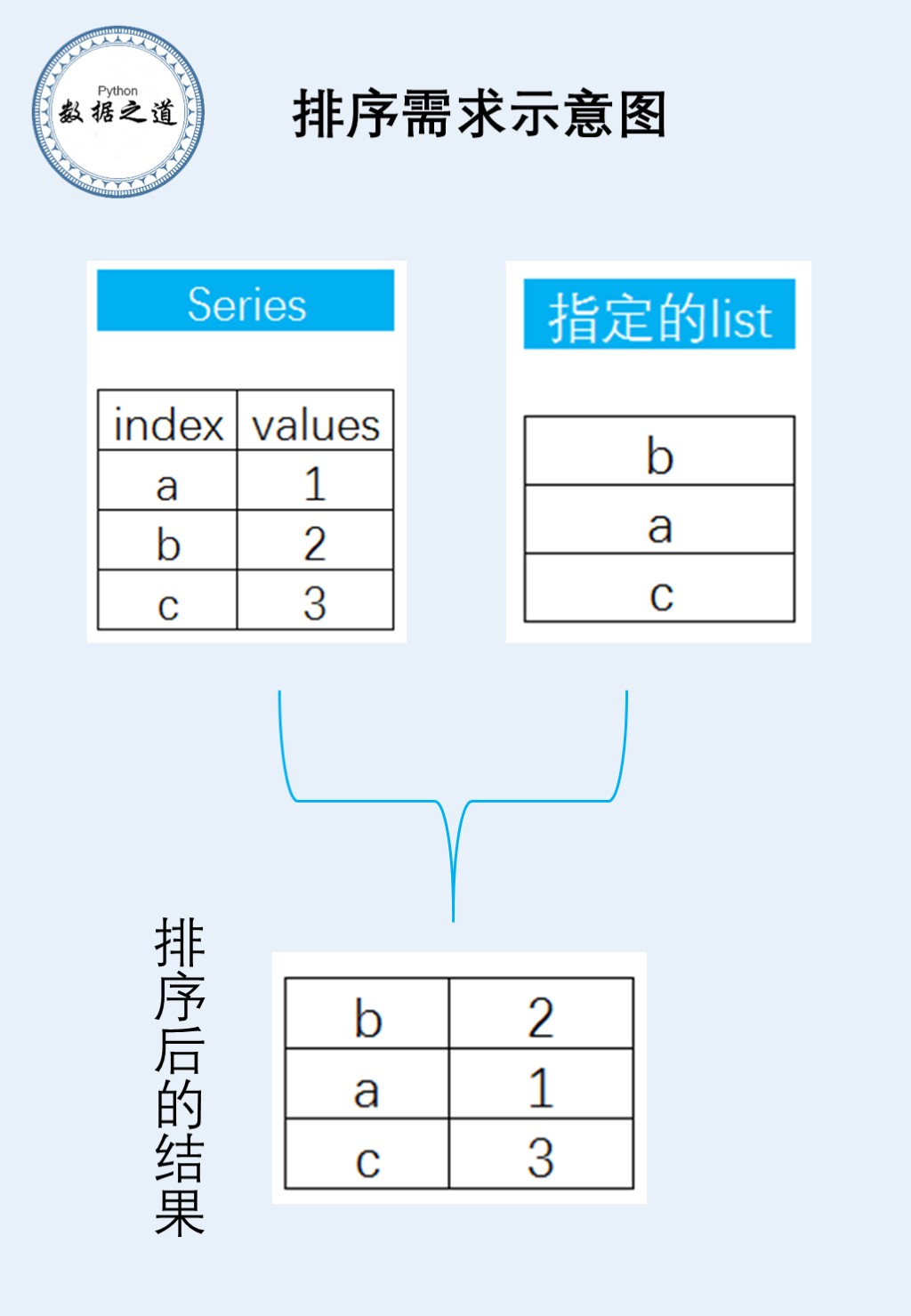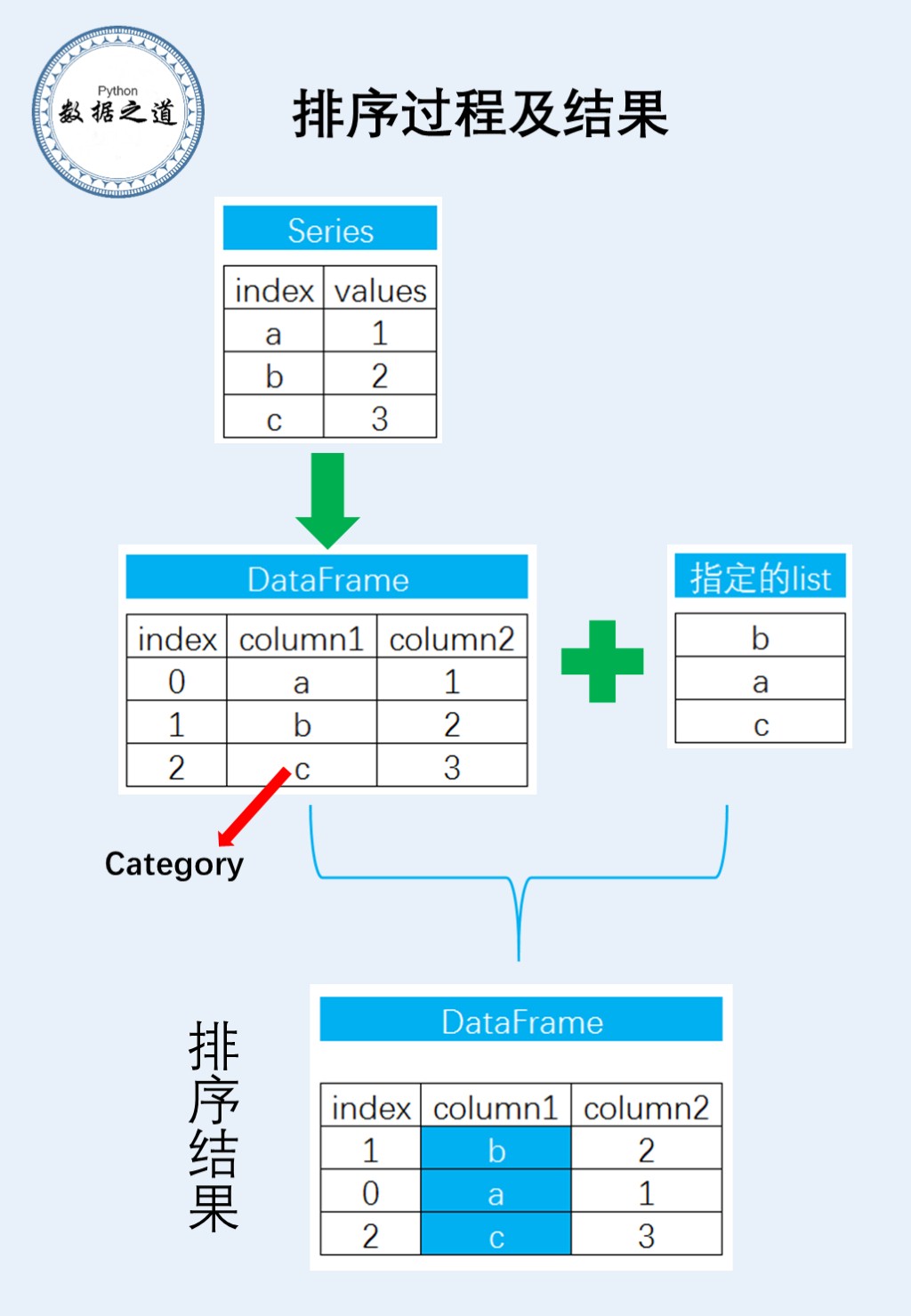Python: Pandas的DataFrame如何按指定list排序
阿新 • • 發佈:2017-06-14
不同 需求 per log title 表示 anr lac 使用
本文首發於微信公眾號“Python數據之道”(ID:PyDataRoad)
前言
寫這篇文章的起由是有一天微信上一位朋友問到一個問題,問題大體意思概述如下:
現在有一個pandas的Series和一個python的list,想讓Series按指定的list進行排序,如何實現?
這個問題的需求用流程圖描述如下:

我思考了一下,這個問題解決的核心是引入pandas的數據類型“category”,從而進行排序。
在具體的分析過程中,先將pandas的Series轉換成為DataFrame,然後設置數據類型,再進行排序。思路用流程圖表示如下:

分析過程
- 引入pandas庫
import pandas as pd
- 構造Series數據
s = pd.Series({‘a‘:1,‘b‘:2,‘c‘:3})
s
a 1
b 2
c 3
dtype: int64
s.index
Index([‘a‘, ‘b‘, ‘c‘], dtype=‘object‘)
- 指定的list,後續按指定list的元素順序進行排序
list_custom = [‘b‘, ‘a‘, ‘c‘]
list_custom
[‘b‘, ‘a‘, ‘c‘]
- 將Series轉換成DataFrame
df = pd.DataFrame(s) df = df.reset_index() df.columns = [‘words‘, ‘number‘] df
| words | number | |
|---|---|---|
| 0 | a | 1 |
| 1 | b | 2 |
| 2 | c | 3 |
設置成“category”數據類型
# 設置成“category”數據類型
df[‘words‘] = df[‘words‘].astype(‘category‘)
# inplace = True,使 recorder_categories生效
df[‘words‘ | words | number | |
|---|---|---|
| 1 | b | 2 |
| 0 | a | 1 |
| 2 | c | 3 |
指定list元素多的情況:
若指定的list所包含元素比Dataframe中需要排序的列的元素多,怎麽辦?
- reorder_catgories()方法不能繼續使用,因為該方法使用時要求新的categories和dataframe中的categories的元素個數和內容必須一致,只是順序不同。
- 這種情況下,可以使用 set_categories()方法來實現。新的list可以比dataframe中元素多。
list_custom_new = [‘d‘, ‘c‘, ‘b‘,‘a‘,‘e‘]
dict_new = {‘e‘:1, ‘b‘:2, ‘c‘:3}
df_new = pd.DataFrame(list(dict_new.items()), columns=[‘words‘, ‘value‘])
print(list_custom_new)
df_new.sort_values(‘words‘, inplace=True)
df_new
[‘d‘, ‘c‘, ‘b‘, ‘a‘, ‘e‘]
| words | value | |
|---|---|---|
| 0 | b | 2 |
| 1 | c | 3 |
| 2 | e | 1 |
df_new[‘words‘] = df_new[‘words‘].astype(‘category‘)
# inplace = True,使 set_categories生效
df_new[‘words‘].cat.set_categories(list_custom_new, inplace=True)
df_new.sort_values(‘words‘, ascending=True)
| words | value | |
|---|---|---|
| 1 | c | 3 |
| 0 | b | 2 |
| 2 | e | 1 |
指定list元素少的情況:
若指定的list所包含元素比Dataframe中需要排序的列的元素少,怎麽辦?
- 這種情況下,set_categories()方法還是可以使用的,只是沒有的元素會以NaN表示
註意下面的list中沒有元素“b”
list_custom_new = [‘d‘, ‘c‘,‘a‘,‘e‘]
dict_new = {‘e‘:1, ‘b‘:2, ‘c‘:3}
df_new = pd.DataFrame(list(dict_new.items()), columns=[‘words‘, ‘value‘])
print(list_custom_new)
df_new.sort_values(‘words‘, inplace=True)
df_new
[‘d‘, ‘c‘, ‘a‘, ‘e‘]
| words | value | |
|---|---|---|
| 0 | b | 2 |
| 1 | c | 3 |
| 2 | e | 1 |
df_new[‘words‘] = df_new[‘words‘].astype(‘category‘)
# inplace = True,使 set_categories生效
df_new[‘words‘].cat.set_categories(list_custom_new, inplace=True)
df_new.sort_values(‘words‘, ascending=True)
| words | value | |
|---|---|---|
| 0 | NaN | 2 |
| 1 | c | 3 |
| 2 | e | 1 |
總結
根據指定的list所包含元素比Dataframe中需要排序的列的元素的多或少,可以分為三種情況:
- 相等的情況下,可以使用 reorder_categories和 set_categories方法;
- list的元素比較多的情況下, 可以使用set_categories方法;
- list的元素比較少的情況下, 也可以使用set_categories方法,但list中沒有的元素會在DataFrame中以NaN表示。
源代碼
需要的童鞋可在微信公眾號“Python數據之道”(ID:PyDataRoad)後臺回復關鍵字獲取視頻,關鍵字如下:
“2017-025”(不含引號)
?Python: Pandas的DataFrame如何按指定list排序
